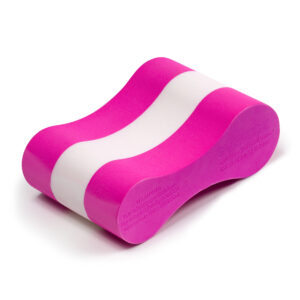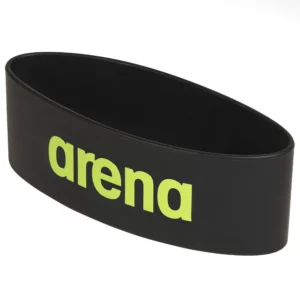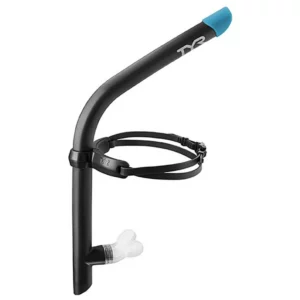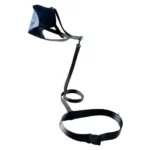Our swim school is Qualitop certified and recognized by numerous health insurance providers. This means, depending on your insurance plan, a portion of the course fees may be reimbursed. Please check with your health insurance provider for specific details.
Swimming school » Blog » Essential Swimming Training Aids: Pros, Cons and Tips
Essential Swimming Training Aids: Pros, Cons and Tips
Using the right swimming training aid can help you improve swim techniques, build strength, and swim more efficiently – or simply bring more variety and fun into your training. Whether you’re beginner or training for triathlon, here’s a breakdown of popular training aids, their benefits, drawbacks, and ideal user levels.
Kickboard

The kickboard is probably the most recognizable swimming aid. It’s used to isolate your legs so you can focus entirely on your kick technique. It’s also a great tool for complete beginners to get started with swimming, as it offers extra balance and control while learning basic leg movements.
- Benefits: Builds lower body endurance, improves kick rhythm, enhances ankle flexibility, and gives new swimmers added stability.
- Cons: Can encourage poor body position if overused.
- Level: Beginner to
- Pro Tip: Vary your drills by keeping your head sometimes underwater and sometimes above water. This way, you train breathing, head position, and body balance at the same time.
Paddles

Hand paddles increase the surface area of your hands, helping you develop strength and a better feel for the water.
- Benefits: Strengthens the pulling muscles (lats, shoulders, triceps) and gives immediate feedback on hand positioning.
- Cons: Risk of shoulder strain if used too much, with paddles that are too big, or with poor technique; can mask underlying stroke flaws.
- Level: Intermediate to Pro
- Pro Tip: Remove the strap over your wrist to execute your arm pull more precisely and develop a better feel for the water.
Pull Buoy

A pull buoy is placed between your thighs (or ankles for an extra challenge) to keep your legs afloat, allowing you to focus on your upper body pull and improve body position.
- Benefits: Builds upper body strength, improves body position, and helps you feel proper rotation.
- Cons: Can cause core disengagement; may create dependency that hides poor kick technique.
- Level: Beginner to Pro
- Pro Tip: Try different pull buoys to find the one that best fits your body type
Fins

Swim fins are generally shorter than diving fins and allow swimmers to improve kick efficiency, ankle flexibility, and overall speed.
- Benefits: Increases propulsion, helps develop a stronger and more efficient kick, improves ankle mobility, and makes it easier to maintain body position and cover longer distances.
- Cons: Overuse can lead to dependency; certain stiff fins may cause calf or ankle strain if not used gradually.
- Level: Beginner to Pro
- Pro Tip: Wear fins on only one foot at first, then switch. This will improve your awareness of your feet in the water. This method also works well in combination with paddles.
Ankle Band

An ankle band ties your feet together, eliminating your kick and forcing you to rely entirely on your upper body and core for propulsion.
- Benefits: Builds upper body power, increases core stability, and exposes any body-position flaws.
- Cons: Very challenging without a pull buoy; can cause hips to drop if core strength is lacking.
- Level: Intermediate to Pro
- Pro Tip: Use an old bike tube as an ankle band – simply cut it to the right length, tie it together, and start swimming.
Snorkel

A front-mounted snorkel allows you to swim without turning your head to breathe, so you can focus entirely on body alignment and stroke mechanics.
- Benefits: Improves body position, helps identify asymmetries, and reduces neck strain.
- Cons: Can reduce awareness of natural breathing rhythm; some swimmers find it uncomfortable or difficult to clear water from.
- Level: Intermediate to Pro
- Pro Tip: If you have trouble controlling your breathing, use nose clips – this allows you to fully focus on technique without water entering your nose.
Anti-Paddles

Anti-paddles are designed with a hole or reduced surface area, making pulling harder by reducing your grip in the water.
- Benefits: Forces a more efficient catch, engages the forearms more, and increases stroke awareness.
- Cons: Not ideal for strength building; can feel awkward and frustrating for beginners.
- Level: Intermediate to Pro
- Pro Tip: Make your hands into fists while swimming – the effect is similar to training with anti-paddles.
Tempo Trainer

A tempo trainer is a small device (often worn under your swim cap) that beeps at a set interval, helping you regulate stroke rate and pacing.
- Benefits: Improves stroke rate consistency, teaches pacing skills, and develops rhythm.
- Cons: Can feel mentally tiring over long sets; too much focus on the beeps may distract from technique.
- Level: Intermediate to Pro
- Pro Tip: Vary the beeps to develop a better sense of different paces.
Added Resistance Tools (Resistance Shorts, Drag Socks, Parachute)


These tools create extra drag in the water, making each movement more demanding. Resistance shorts and socks add subtle drag, while parachutes provide more intense resistance.
- Benefits: Builds overall power, enhances endurance, and makes regular swimming feel easier afterward.
- Cons: Can alter natural stroke mechanics if overused; high resistance may cause fatigue that leads to poor form.
- Level: Intermediate to Pro
- Pro Tip: If you want to try a real old-school resistance tool, put on a loose-fitting cotton T-shirt and start your swim training 🙂
Swimming aids are valuable tools to improve technique, strength, and efficiency in the water. However, they should be used purposefully and mindfully to avoid dependency and not interfere with your natural swimming motion. Combine different tools, adjust them to your level, and always focus on proper technique – this way, you get the most out of your training.